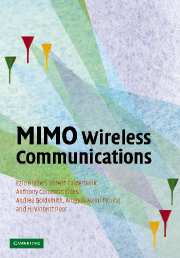Book contents
6 - Multi-user receiver design
Published online by Cambridge University Press: 15 December 2009
Summary
Introduction
The preceding chapter considered the design of receivers for MIMO systems operating as single-user systems. Increasingly however, as noted in Chapters 2 and 4, wireless communication networks operate as shared-access systems in which multiple transmitters share the same radio resources. This is due largely to the ability of shared-access systems to support flexible admission protocols, to take advantage of statistical multiplexing, and to support transmission in unlicensed spectrum. In this chapter we will extend the treatment of Chapter 5 to consider receiver structures for multi-user, and specifically, multiple-access MIMO systems. We will also generalize the channel model considered to include more general situations than the flat-fading channels considered in Chapter 5. To treat these problems, we will first describe a general model for multi-user MIMO signaling, and then discuss the structure of optimal receivers for this signal model. This model will generally include several sources of interference arising in MIMO wireless systems, including multiple-access interference caused by the sharing of radio resources noted above, inter-symbol interference caused by dispersive channels, and inter-antenna interference caused by the use of multiple transmit antennas. Algorithms for the mitigation of all of these types of interference can be derived in this common framework, leading to a general receiver structure for multi-user MIMO communications over frequency-selective channels. As we shall see, these basic algorithms will echo similar algorithms that have been described in Chapters 3 and 5. Since optimal receivers in this situation are often prohibitively complex, the bulk of the chapter will focus on useful lower complexity sub-optimal iterative and adaptive receiver structures that can achieve excellent performance in mitigating interference in such systems. This discussion is organized as follows.
Information
- Type
- Chapter
- Information
- MIMO Wireless Communications , pp. 230 - 292Publisher: Cambridge University PressPrint publication year: 2007
